Apocalypse
黙示 −双家族−
Silence as a Fissure
What emerges from the fissure revealed by the photograph is another portrait, another visage. These faces have no social veneer, no personal or psychological barriers. Yet, could it be that these faces are not merely brought forth by the gaze of those who view the photographs of the Japanese remaining in China but also by the pressure of the viewers’ own gaze? They are “portraits of time (history)” that appear within the relationship of “seeing/being seen (taking/being taken).”
Further intensifying this exchange of gazes is the “Dual Families.” The “Dual Families” capture families living in two different countries due to various circumstances while achieving reunion with their relatives, juxtaposing them as “pairs.” Here lies the photographer’s wish to perpetually bind these two families. Unlike “Who Am I?” where the subject’s position is shifted from the center or the background is prominently included, the photographer’s direction is more apparent in “Dual Families.” Perhaps the photographer’s wish or intention compelled a portrayal closer to a conventional portrait. Yet, viewers of “Dual Families” cannot escape the same pressure of gaze as in “Who Am I?”
There’s a sense of perplexity and anxiety in the gazes of the Japanese remaining in China and their relatives. Could it be the unease and anxiety of being exposed to the public sphere of history through being photographed? Perhaps each family has various circumstances related to the past and present, some of which might hinder simple rejoicing in reunion. They, too, bear the intrusion of darkness from a deep past. The photographer confronts the weight of their gaze.
To fulfill the photographer’s wish to connect the two families, perhaps demanding a bit more smiles could have been acceptable. It might have been appropriate to stage scenes to evoke the joy of reunion. However, the weight of their gazes prevents the photographer from excessive staging. “Dual Families” stands on the brink of conventional portrait photography.
This tension intensifies the pressure of the gaze on the viewer. It is also the gaze of the photographer, Shinsei Okamoto (while simultaneously being the gaze of the viewer of the photograph). The photographer’s (viewer’s) cruelty in further widening and exposing their past fissures by capturing (observing) them. Yet, on the other hand, there’s a sense of duty in revealing this “silence as a fissure.” The viewers confront this “silence as a fissure.” In “Dual Families,” we not only witness Shinsei Okamoto’s most sincere confrontation with history but also become aware of the primal power inherent in photography as a medium. This primal power is none other than the “fissure” brought about by “seeing/being seen (taking/being taken).” / ChatGPT
Excerpt from “Rhetoric of Silence” by Hiroshi Oshima
Further intensifying this exchange of gazes is the “Dual Families.” The “Dual Families” capture families living in two different countries due to various circumstances while achieving reunion with their relatives, juxtaposing them as “pairs.” Here lies the photographer’s wish to perpetually bind these two families. Unlike “Who Am I?” where the subject’s position is shifted from the center or the background is prominently included, the photographer’s direction is more apparent in “Dual Families.” Perhaps the photographer’s wish or intention compelled a portrayal closer to a conventional portrait. Yet, viewers of “Dual Families” cannot escape the same pressure of gaze as in “Who Am I?”
There’s a sense of perplexity and anxiety in the gazes of the Japanese remaining in China and their relatives. Could it be the unease and anxiety of being exposed to the public sphere of history through being photographed? Perhaps each family has various circumstances related to the past and present, some of which might hinder simple rejoicing in reunion. They, too, bear the intrusion of darkness from a deep past. The photographer confronts the weight of their gaze.
To fulfill the photographer’s wish to connect the two families, perhaps demanding a bit more smiles could have been acceptable. It might have been appropriate to stage scenes to evoke the joy of reunion. However, the weight of their gazes prevents the photographer from excessive staging. “Dual Families” stands on the brink of conventional portrait photography.
This tension intensifies the pressure of the gaze on the viewer. It is also the gaze of the photographer, Shinsei Okamoto (while simultaneously being the gaze of the viewer of the photograph). The photographer’s (viewer’s) cruelty in further widening and exposing their past fissures by capturing (observing) them. Yet, on the other hand, there’s a sense of duty in revealing this “silence as a fissure.” The viewers confront this “silence as a fissure.” In “Dual Families,” we not only witness Shinsei Okamoto’s most sincere confrontation with history but also become aware of the primal power inherent in photography as a medium. This primal power is none other than the “fissure” brought about by “seeing/being seen (taking/being taken).” / ChatGPT
Excerpt from “Rhetoric of Silence” by Hiroshi Oshima
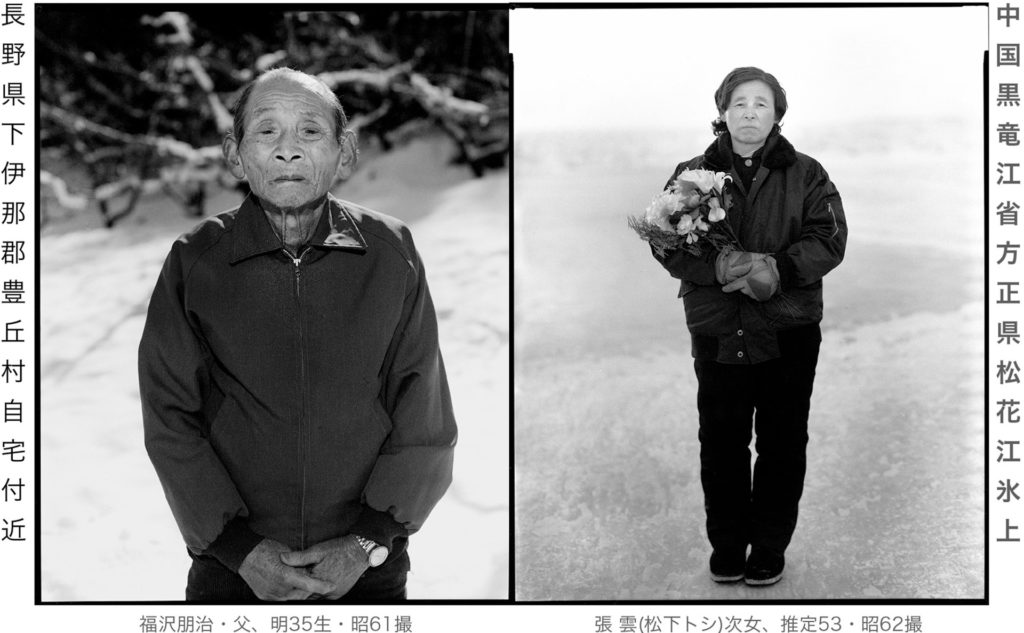
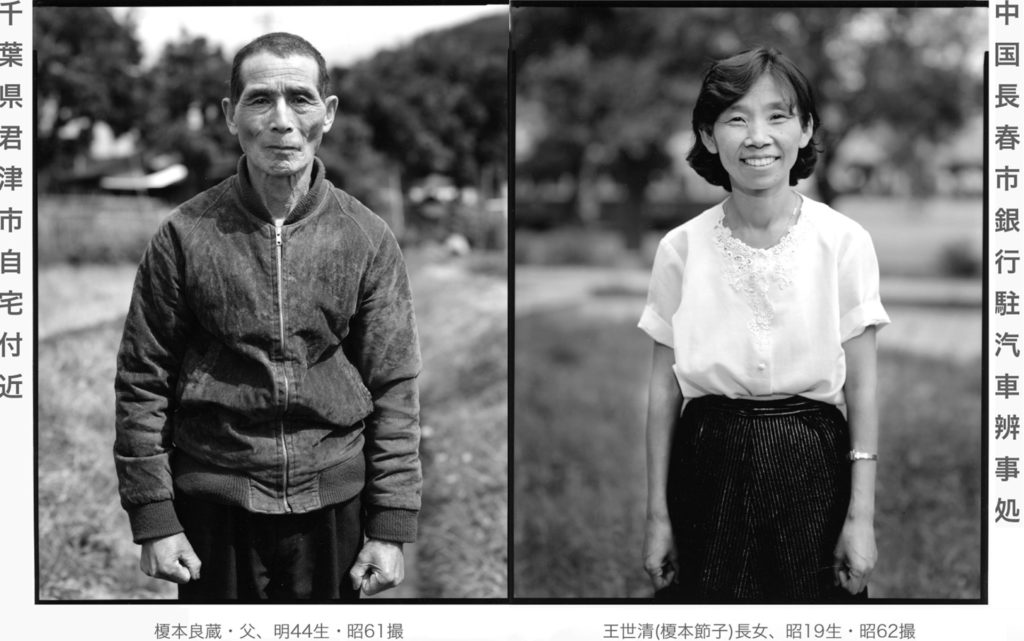
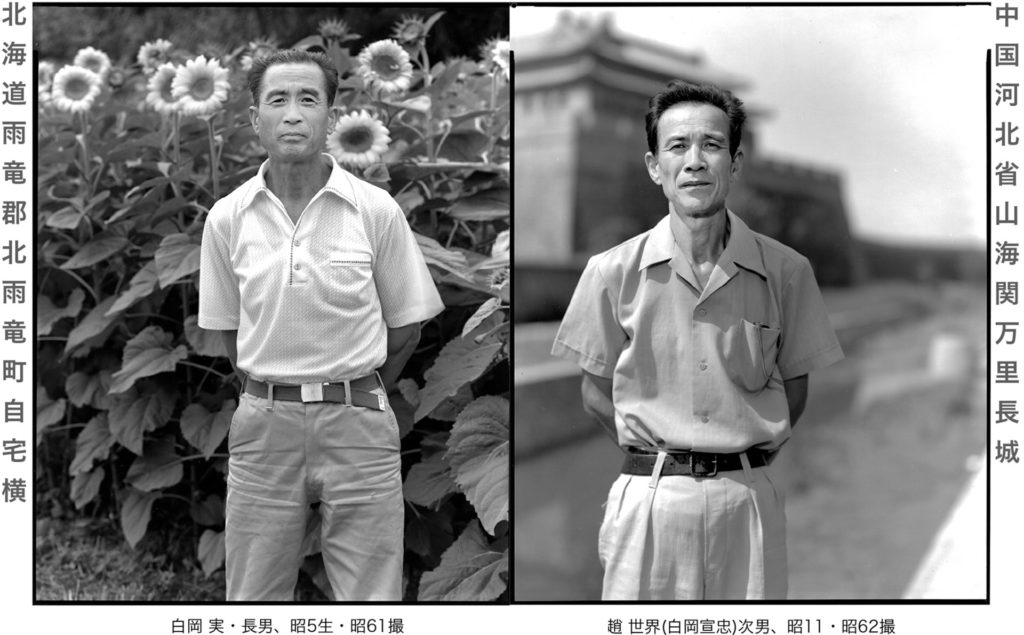
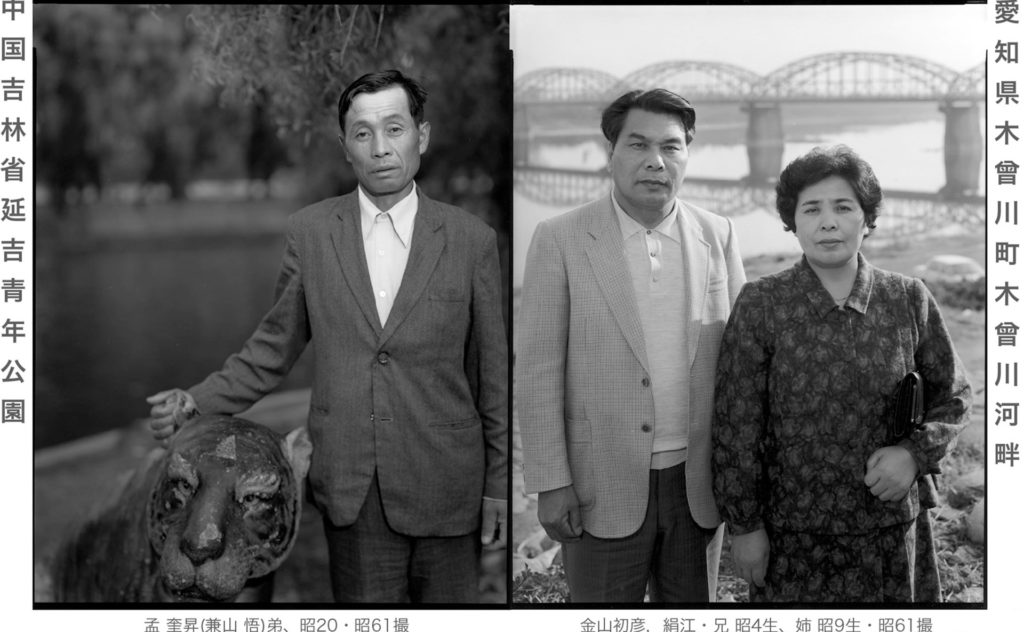
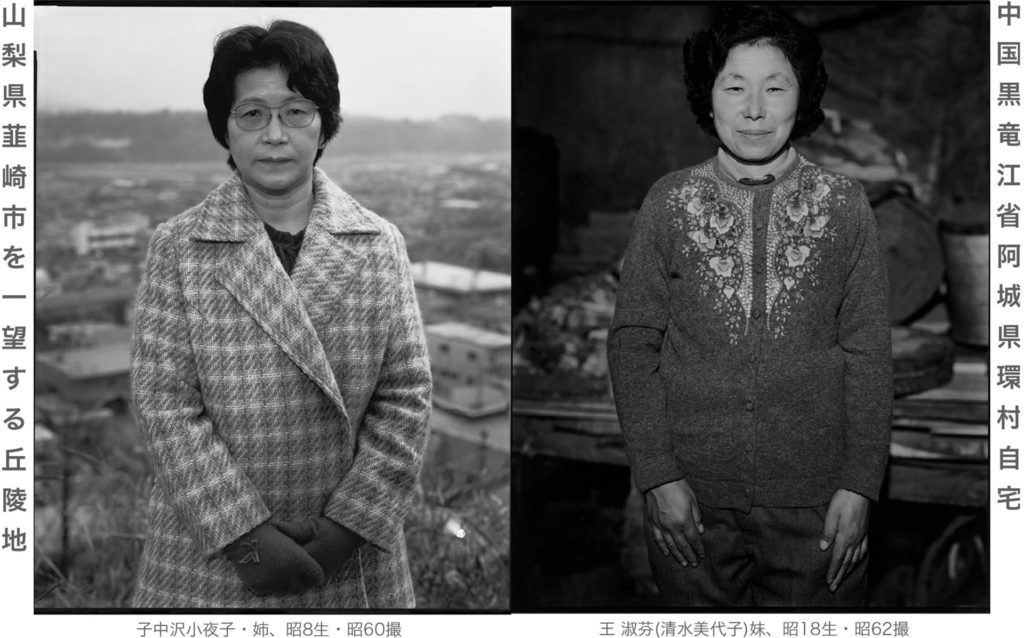
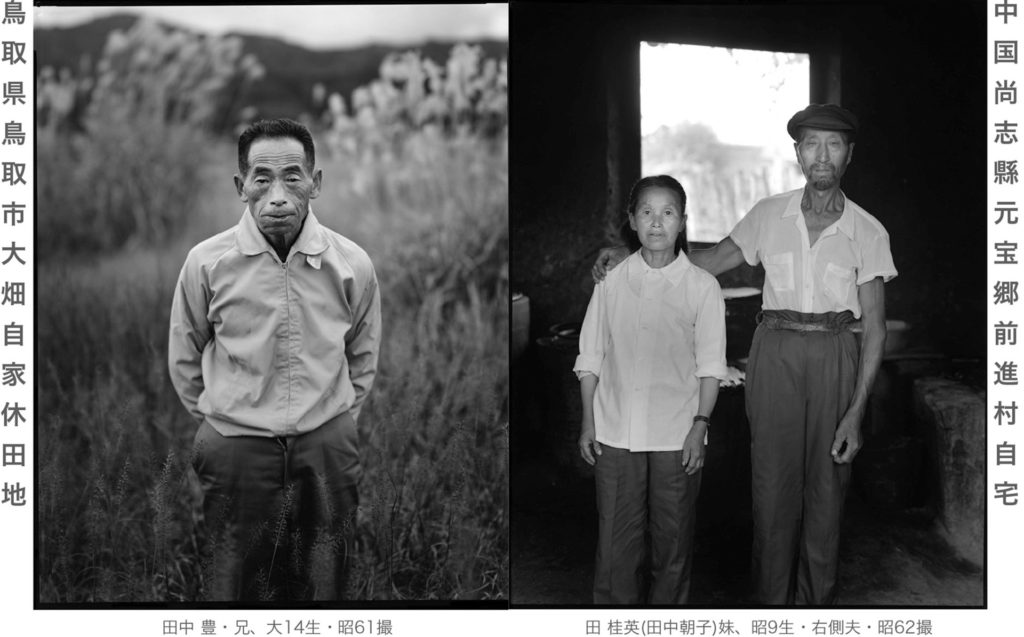
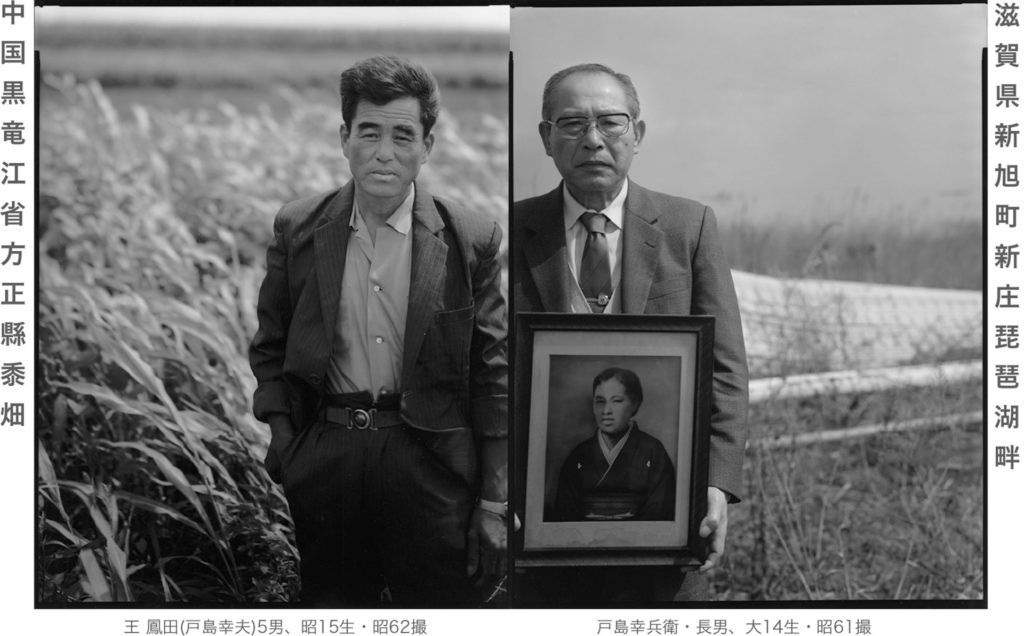
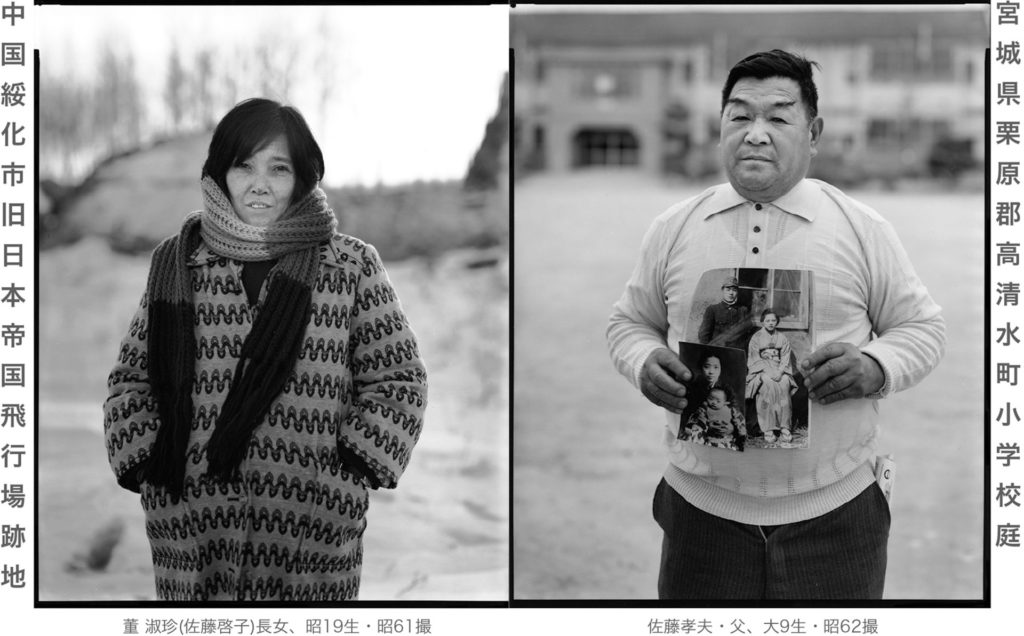
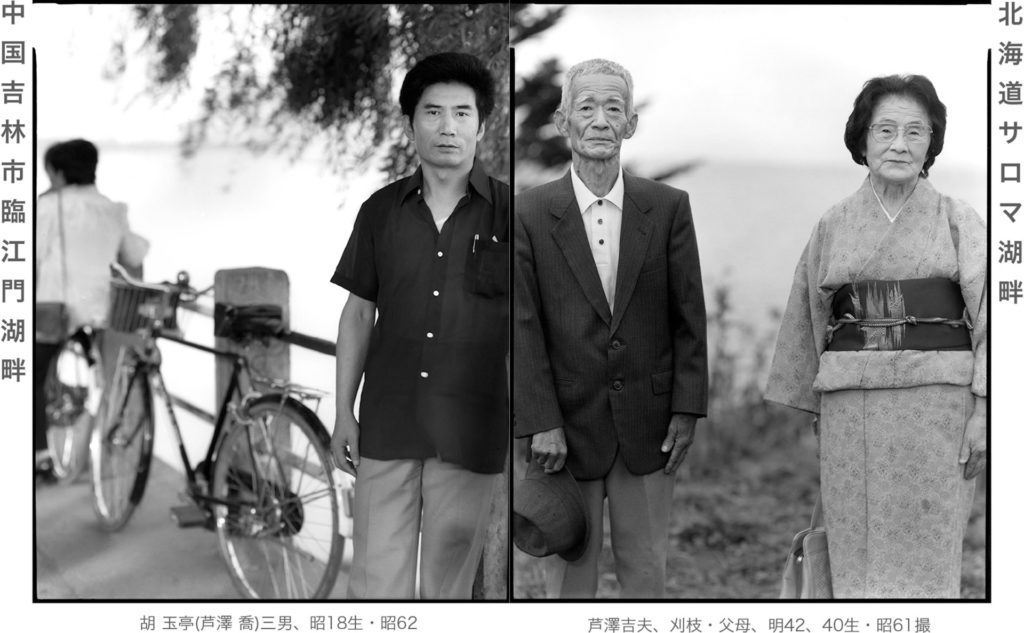
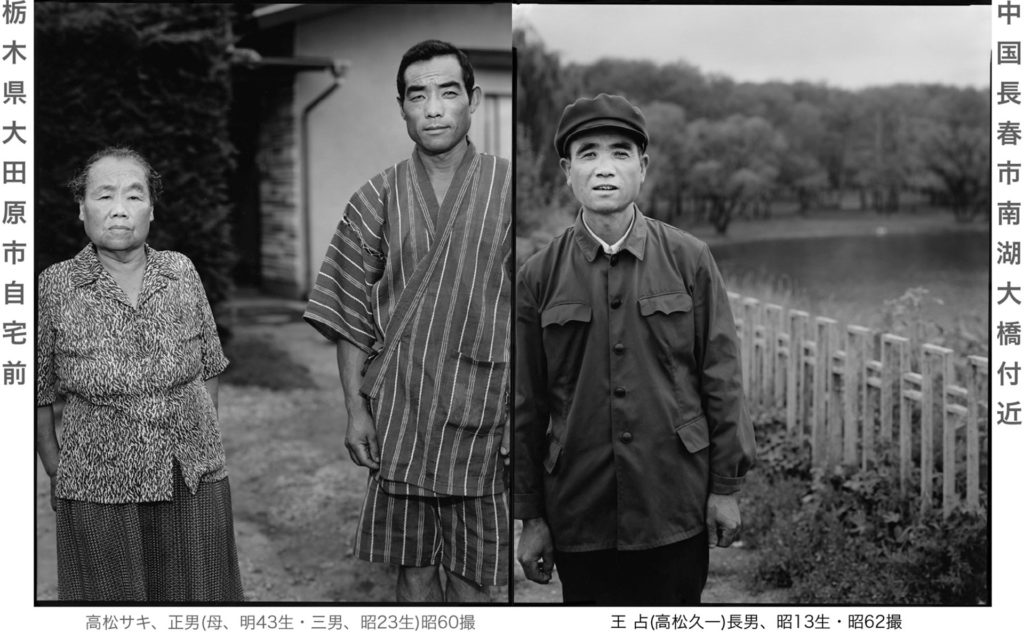
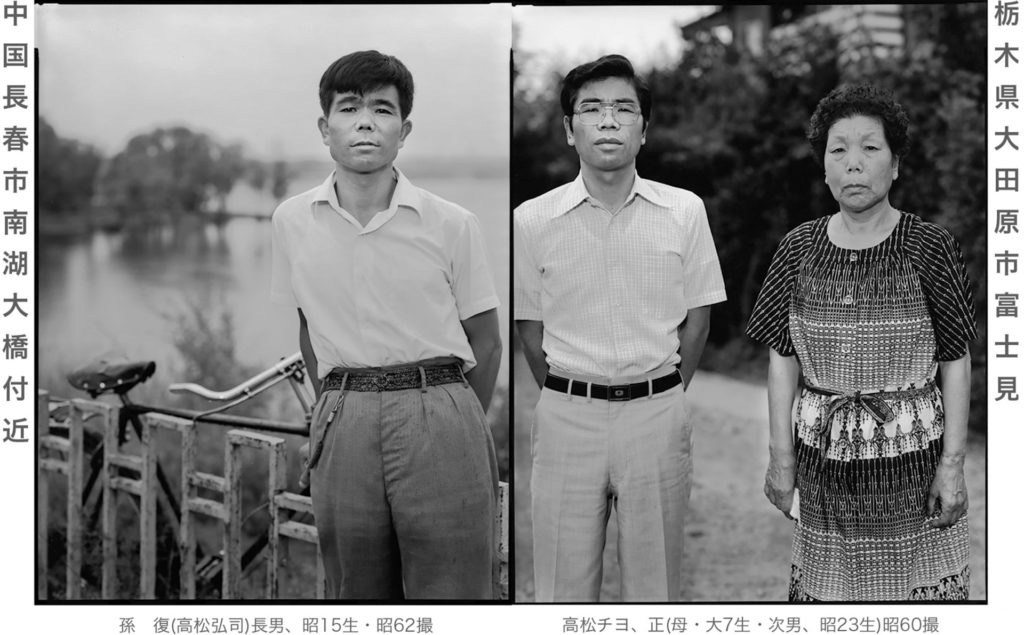
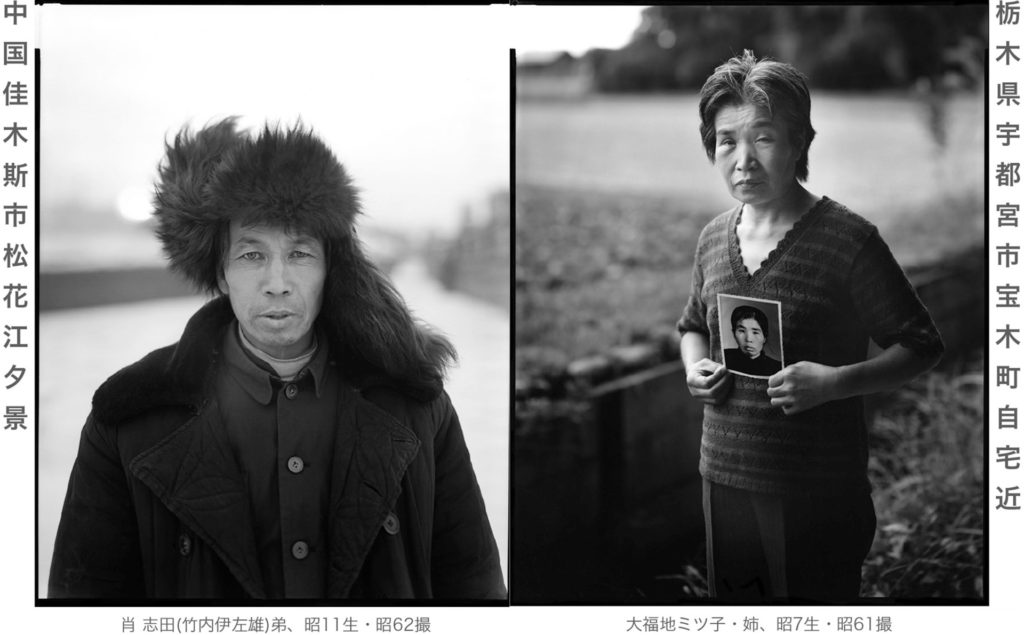
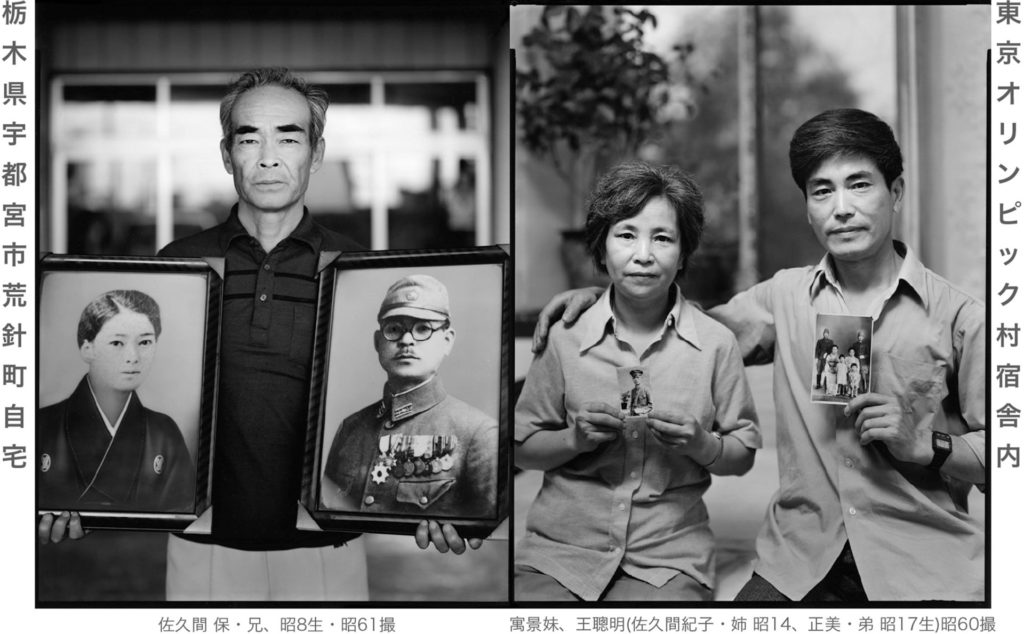
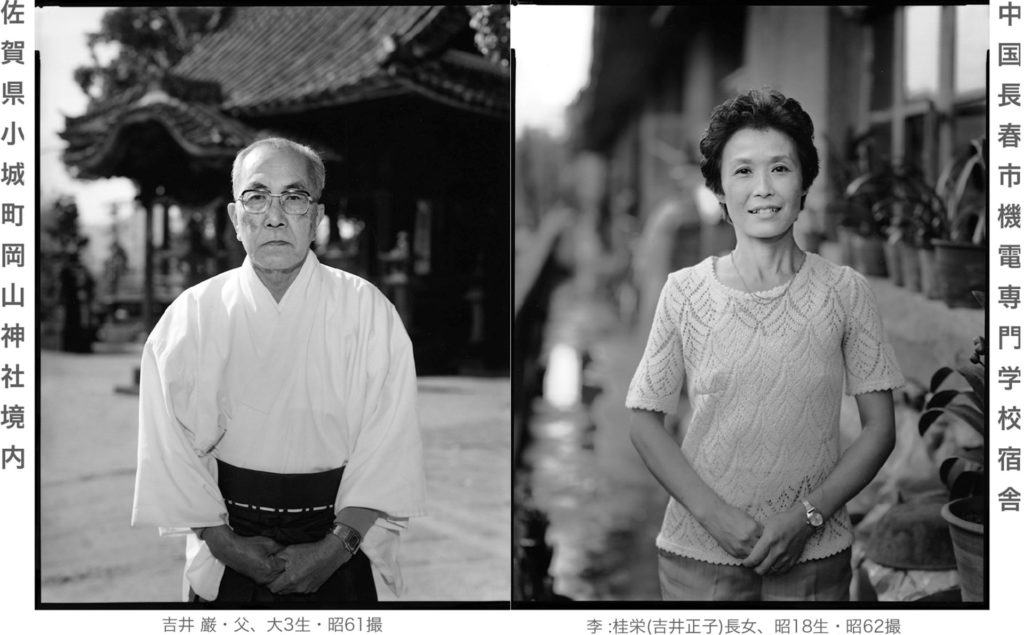
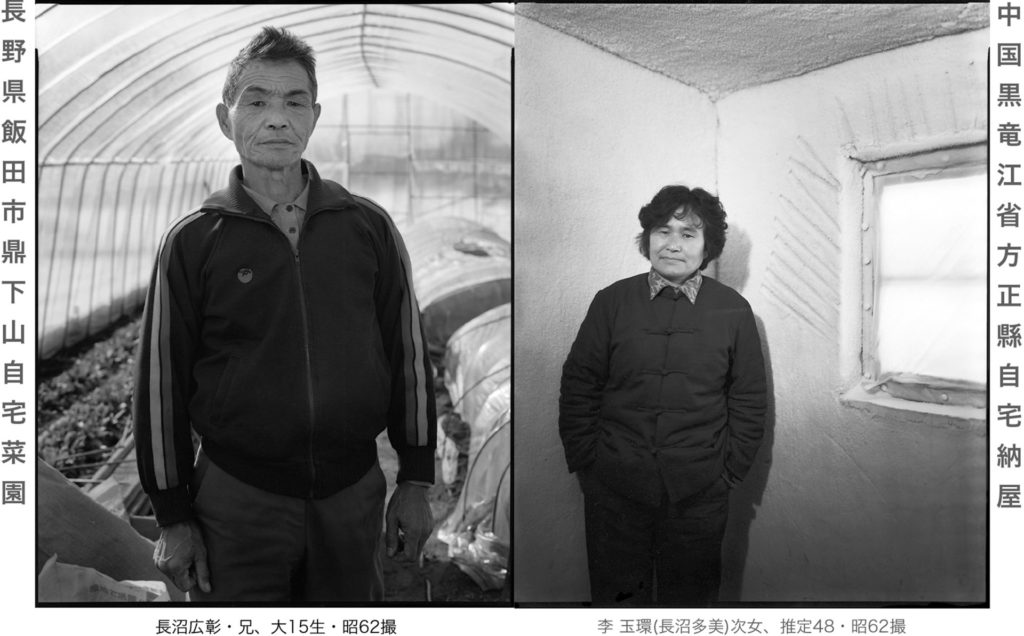
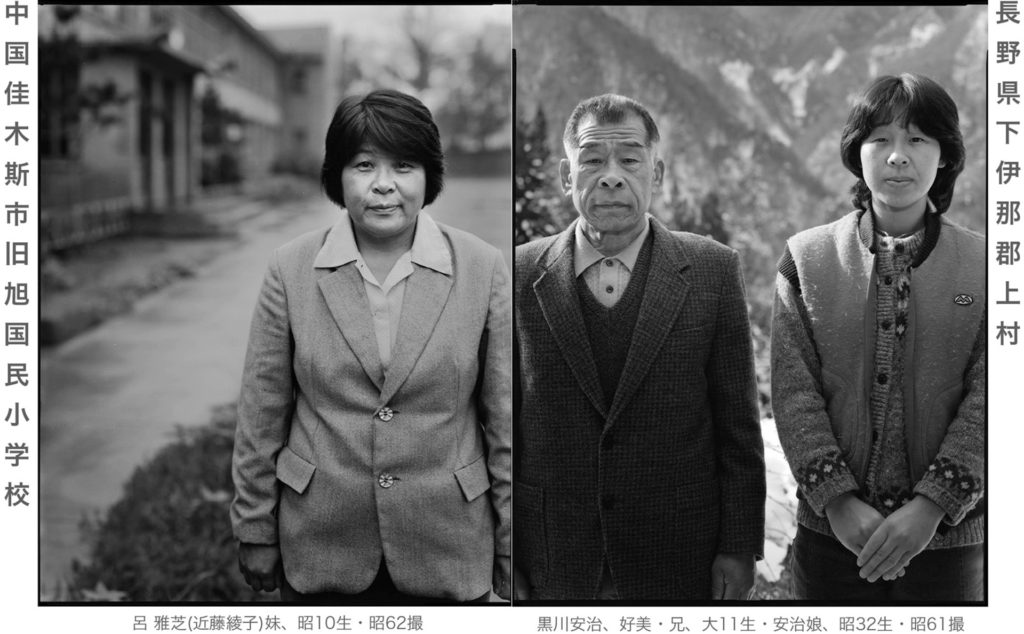
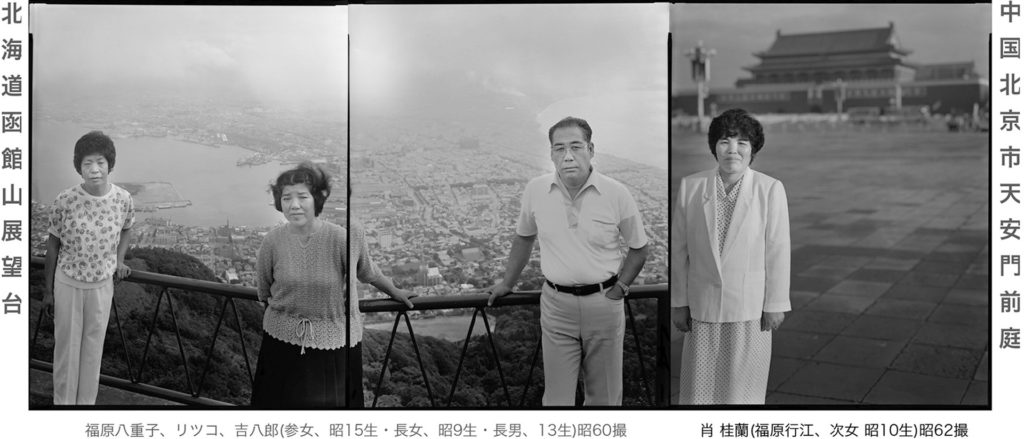
裂け目としての沈黙
写真によってあらわにされた裂け目から浮かんでくるのは、もう一つの肖像(顔)である。これらの顔には社会的なみせかけも、個人的・心理的な障壁もない。しかし、これらの顔は、中国残留日本人たちのまなざしが写真を見る者に跳ね返って、見る者自身の視線の圧力となってもたらされたものではないだろうか。“見る/見られる(撮る/撮られる)”という関係性のなかで現れる、“時間(歴史)の肖像”。
この“見る/見られる”という視線の交換を、さらに強く感じさせるのが「双家族」である。「双家族」は肉親との再会を果たしながらも、何らかの事情によって、二つの国に引き裂かれながら生きなければならない家族を、それぞれの地で撮影し、「一対」として並べたものである。ここには、 二つの家族を永遠に結びつけたいという、写真家の願いが込められている。実際、「双家族」では『私は誰ですか』とはちがい、被写体の位置を中心からずらしたり、背景を大きく取り入れたりと、写真家の演出がほどこされている。写真家の願い(意図)が、より肖像写真に近いものとして撮ることを強いたといえるかもしれない。しかし、「双家族」を見る者は、『私は誰ですか』と同様の視線の圧力を感じざるを得ない。
「双家族」の中国残留日本人とその肉親のまなざしには、どこか戸惑いと不安のようなものが漂っている。それは写真に撮られることによって、歴史という公の場に晒されることの戸惑いと不安だろうか。おそらくそれぞれの家族には過去と現在に関わるさまざまな事情がある。再会を単純に喜べない事情さえあるかもしれない。彼らもまた深い過去からの闇の侵入を引き受けているのだ。写真家はそのまなざしの重さと対峙する。
二つの家族を結びつけたいという写真家の願いに応えてもらうためには、もう少し笑みを要求してもよかったかもしれない。再会の喜びを喚起させるための演出をほどこしてもよかったかもしれない。しかし、彼らのまなざしの重さが、写真家に行きすぎた演出を回避させる。「双家族」はいわゆる肖像写真の、一歩手前のぎりぎりのところで成立している写真ともいえるだろう。
この緊張感こそが見る者により強い視線の圧力を感じさせるのだ。それはまた写真家・新正卓自身の視線である(と同時にまた、写真を見る者の視線でもある)。彼らを撮る(見る)ことで、彼らの過去の裂け目をさらに押し広げ、晒してしまうという写真家(見る者)の残酷さ。しかし一方で、 その“裂け目としての沈黙”をあらわにすることが写真家の役割であるという使命感。そして、写真を見る者はその“裂け目としての沈黙”と対峙することになる。われわれはこの「双家族」のなかに新正卓が歴史と向き合う最も真摯な姿勢を見ると同時に、写真というメディウムがもっている始原的な力に気づかされる。 この始原的な力こそ、“見る/見られる(撮る/撮られる)”ことによってもたらされた“裂け目”にほかならない。
(「沈黙の叙法」からの抜粋 大嶋浩 )
この“見る/見られる”という視線の交換を、さらに強く感じさせるのが「双家族」である。「双家族」は肉親との再会を果たしながらも、何らかの事情によって、二つの国に引き裂かれながら生きなければならない家族を、それぞれの地で撮影し、「一対」として並べたものである。ここには、 二つの家族を永遠に結びつけたいという、写真家の願いが込められている。実際、「双家族」では『私は誰ですか』とはちがい、被写体の位置を中心からずらしたり、背景を大きく取り入れたりと、写真家の演出がほどこされている。写真家の願い(意図)が、より肖像写真に近いものとして撮ることを強いたといえるかもしれない。しかし、「双家族」を見る者は、『私は誰ですか』と同様の視線の圧力を感じざるを得ない。
「双家族」の中国残留日本人とその肉親のまなざしには、どこか戸惑いと不安のようなものが漂っている。それは写真に撮られることによって、歴史という公の場に晒されることの戸惑いと不安だろうか。おそらくそれぞれの家族には過去と現在に関わるさまざまな事情がある。再会を単純に喜べない事情さえあるかもしれない。彼らもまた深い過去からの闇の侵入を引き受けているのだ。写真家はそのまなざしの重さと対峙する。
二つの家族を結びつけたいという写真家の願いに応えてもらうためには、もう少し笑みを要求してもよかったかもしれない。再会の喜びを喚起させるための演出をほどこしてもよかったかもしれない。しかし、彼らのまなざしの重さが、写真家に行きすぎた演出を回避させる。「双家族」はいわゆる肖像写真の、一歩手前のぎりぎりのところで成立している写真ともいえるだろう。
この緊張感こそが見る者により強い視線の圧力を感じさせるのだ。それはまた写真家・新正卓自身の視線である(と同時にまた、写真を見る者の視線でもある)。彼らを撮る(見る)ことで、彼らの過去の裂け目をさらに押し広げ、晒してしまうという写真家(見る者)の残酷さ。しかし一方で、 その“裂け目としての沈黙”をあらわにすることが写真家の役割であるという使命感。そして、写真を見る者はその“裂け目としての沈黙”と対峙することになる。われわれはこの「双家族」のなかに新正卓が歴史と向き合う最も真摯な姿勢を見ると同時に、写真というメディウムがもっている始原的な力に気づかされる。 この始原的な力こそ、“見る/見られる(撮る/撮られる)”ことによってもたらされた“裂け目”にほかならない。
(「沈黙の叙法」からの抜粋 大嶋浩 )
